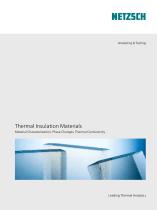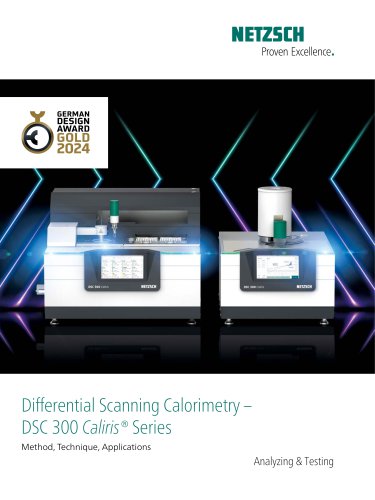 Website:
NETZSCH Analyzing & Testing
Website:
NETZSCH Analyzing & Testing
Group: NETZSCH
Catalog excerpts

Analyzing & Testing Thermal Insulation Materials Material Characterization, Phase Changes, Thermal Conductivity Leading Thermal Analysis
Open the catalog to page 1
Thermal insulation materials are specifically designed to reduce the heat flow by limiting heat conduction, convection, radiation or all three while performing one or more of the following functions: ■ Conserving energy by reducing heat loss or gain ■ Controlling surface temperatures for personnel protection and comfort ■ Facilitating vapor flow and water condensation of a process ■ Increasing operating efficiency of heating/ventilating/cooling, plumbing, steam, process and power systems found in commercial and industrial installations ■ Assisting mechanical systems in meeting standard...
Open the catalog to page 2
Main Modes of Heat Transfer Heat transfer is the transition of thermal energy, or simply heat, from a hotter object to a cooler object. There are three main modes of heat transfer: Convection is usually the dominant form of heat transfer in liquids and gases. Convection comprises the combined effects of conduction and fluid flow. In convection, enthalpy transfer occurs by the movement of hot or cold portions of the fluid/gas together with heat transfer by conduction. Radiation is the only form of heat transfer that can occur in the absence of any form of medium (i.e., in a vacuum). Thermal...
Open the catalog to page 3
Testing Insulation Materials ide Carb e pper , Sili con Diam ond Fibe r Bo Build ards, Fib er In ing B sula oard tion s, O s, ils Woo d, Po lyme rs, C oal Wat er Con crete , Gla ss, F ire C Poro lay us C eram ics, R efra ctor ies Alum ono silic Silico n Ni ates tride Air, Micr opo Poly styre rous Ins ul ne, P U Fo ations ams system to achieve the required efficiency, and what are the best materials to use? How do I design a heat exchanger from an electronic component? How can I improve the heat transfer How does this change with the What is the heating ooling load of /c For highly...
Open the catalog to page 4
The guarded hot plate and heat flow meter methods are standardized test techniques. The "insulation materials" application has many standards associated with it. The NETZSCH GHP 456 and HFM 436 series instruments are confirmed for compliance with all of these. Examples for hot wire standards are listed as well. international Standards
Open the catalog to page 5
Determination of Thermal Conductivity – Instruments Thermal Conductivity Thermal Conductivity λ is a thermophysical property that determines the ability of a material to transfer heat. The value of the thermal conductivity is characterized by the quantity of heat passing per unit of time per unit area at a temperature drop of 1°C per unit length. It depends on the medium‘s phase, temperature, density, molecular bonding, humidity and pressure. The R value is a measure of thermal resistance used in the building and construction industry. The higher the number, the better the effectiveness of...
Open the catalog to page 6
Thermal Conductivity Tester TCT 426 Principle of Operation The TCT 426 operates according to the hot wire technique. A linear heat source (hot wire) is placed between two test pieces which form the sample. The hot wire is loaded with a constant heating power. The temperature increase at the hot wire, or parallel to it, is measured versus time. Measurements can be carried out from room temperature to 1450°C by placing the sample setup in a stable homogenous furnace. Measurement Techniques Depending on the thermal conductivity of the material, various measurement techniques are available. The...
Open the catalog to page 7
Determination of Thermal Conductivity – Instruments Heat Flow Meters HFM 436 Lambda Series – Quality Control Assured Heat flow meters are accurate, fast and easy-to-operate instruments for measuring the thermal conductivity of low-conductivity materials such as insulations. The heat flow meter is a calibrated instrument which tests according to various standards (see standards on page 5). The HFM 436 Lambda series owes its speed of measurement and precision to patented temperature control (three temperature sensors in each plate) and heat flux measurement technology. Instruments...
Open the catalog to page 8
Hoisting device Thickness gauge Electronics and data acquisition system Upper heat sink Peltier system Hot plate Heat flux transducer Test sample Direction of heat flow Heat flux transducer Cold plate Peltier system Lower heat sink The sample is placed between two heated plates set at different temperatures. The heat flow through the sample is measured by heat flux transducers. After reaching thermal equilibrium, the test is carried out. Only the sample center is used for analysis. The heat flux transducer output is calibrated with a NIST certified reference standard. Cooling system...
Open the catalog to page 9
The GHP 456 Titan® is the ideal tool for researchers and scientists in the field of insulation testing. Based on the well-known, standardized guarded hot plate technique (see page 5), the system features unrivaled performance. Aluminum plates are used to cover a temperature range from -160°C to 250°C. The GHP principle is based on an absolute measurement method and therefore requires no calibration standards. The instrument works with sheeted, individually calibrated PT100 resistance temperature sensors (resolution 1 mK, accuracy in the range of 100 mK). The plate stack is placed in a...
Open the catalog to page 10
NETZ5CH Principle of Operation The hot plate and the guard ring are sandwiched between two samples of the same material and about the same thickness. Auxiliary heaters (cold plates) are placed above and below the samples. The cold plates are heated such that a well-defined, user-selectable temperature difference is established between the hot and the cold plates (over the sample thickness). The power input in the hot plate with area A is then measured as soon as thermal equilibrium is reached. Using the measured sample thicknesses, temperatures and power inputs, the thermal conductivity can...
Open the catalog to page 11
Determination of Specific Heat – Enthalpies – Mass Change – Composition To environmentally and economically develop insulation materials, it is essential to have knowledge and control over their thermal conductivities. Other thermal properties are of equal importance, including specific heat, length change and density. These properties can vary with temperature, pressure, and composition, affecting the transfer and storage of heat. Simultaneous Thermal Analysis Simultaneous Thermal Analysis (STA) generally refers to the simultaneous application of Thermogravimetry (TG) and DSC to one and...
Open the catalog to page 12All NETZSCH Analyzing & Testing catalogs and technical brochures
-
TG 309 Libra Series
24 Pages
-
STA 449 F5 Jupiter®
16 Pages
-
DMA 303 Eplexor
24 Pages
-
ARC® 244 ARC® 254
1 Pages
-
HMOR 422
1 Pages
-
RUL/CIC 421
1 Pages
-
Product Overview
12 Pages
-
Kinexus Prime DSR Series
20 Pages
-
DIL 402 Expedis Select/Supreme
28 Pages
-
Rosand Series
20 Pages
-
Kinexus Prime Series
20 Pages
-
Advanced Materials Testing
32 Pages
-
NTA Fire Testing Systems
20 Pages
-
NTA Guarded Hot Plate Series
16 Pages
-
Cone Calorimeter TCC 918
12 Pages
-
Photo-DSC 204 F1 Phoenix®
8 Pages
-
TMA 402 F1/F3 Hyperion®
16 Pages
-
NTA HotBoxes Test Chambers
16 Pages
-
TA-QMS Coupling
16 Pages
-
STA 2500 Regulus
12 Pages
-
SBA 458 Nemesis®
24 Pages
-
NTA HotBoxes
16 Pages
-
NETZSCH NEVIO Instrument Series
24 Pages
-
LFA 467 HyperFlash® Series
28 Pages
-
LFA 427 - product brochure
24 Pages
-
Kinetics NEO
16 Pages
-
TG-FTIR - product brochure
24 Pages
-
DMA GABO EPLEXOR up to 1500°C
12 Pages
-
DMA GABO DiPLEXOR
8 Pages
-
DIL 402 Expedis Classic
16 Pages
-
DEA 288 Ionic
20 Pages
-
Accelerating Rate Calorimetry
20 Pages
-
GABO DiPLEXOR®
8 Pages
-
GABOMETER®
8 Pages









































































